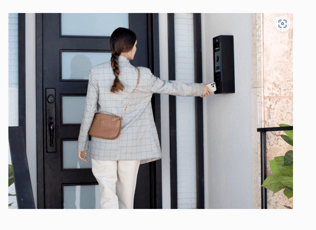Solve the Top 2 Challenges Property Managers Face and Increase RMR
The ability to control door entry is a fundamental part of a community’s overall security solution....


The fear of unauthorized access is a very real threat that needs to be addressed. There are many ways to secure your facility, but one solution is better than all others: Access control systems. Access control ensures only authorized people have access to certain areas of your company’s premises or campus. It also makes it possible for you to monitor and track who enters or leaves any building at any given time, which can help protect against theft, vandalism and other crimes where unauthorized individuals might enter the premises surreptitiously. There’s a wide array of options when it comes to access control. What are some of these options and how do you determine which are right for each project? We are here to break them down a handful to help you determine just that.
Keypads, also known as keypad readers, are used to control access to a building or room. Keypads are typically connected to a control panel that allows you to assign and manage the codes used with each device. You can use keypads in conjunction with other types of access control methods like RFID cards, biometrics (like fingerprint scanners), smart cards and more.
Some keypad systems have standalone capabilities that allow you to set up separate employee numbers for each individual who needs access into your business. This will give them their own passcode so they don’t have to share one with others in the office or building.
Card readers are used to control access to buildings, rooms and other areas just like keypads. The reader reads a card or fob, then either grants or denies entry. If it is allowed, the door unlocks. Card readers are also used to control access to computers in office settings; they are used with smart cards that contain data on their owner’s clearance level (or lack thereof). They can be installed as part of an ID badge system where employees swipe badges through readers at different doors throughout the day – allowing them entrance into restricted areas but not allowing unauthorized individuals beyond certain checkpoints.
Card readers are also used for security purposes at entrances to parking lots and garages where they verify cars’ registration information before unlocking any gates leading into them.
Biometrics are another effective way to secure your organization’s physical assets. Biometric systems are used to identify people by their unique physical characteristics (fingerprints, palm prints, iris scans, etc.). These systems can be used as standalone access control methods or in conjunction with other methods like passwords or PINs.
The most common types of biometric identification include:
An intercom is a small system that allows communication between people in different areas of a building. It is often used to communicate between the reception area and someone who is visiting the office, but it can also be used to connect people in different rooms.
Intercoms are typically placed on walls or doors so that they are easily accessible by visitors and staff alike. They can also be mounted on desks or tables as part of an office furniture set-up if your business has open floor plans that allow for communication throughout the space without walking between rooms all day long!
Call boxes are used to call for help in an emergency. A person can use a call box to call for help when they are locked out of their home, car or office. Call boxes come with multiple options for communication, including audio and video calling features that allow users to speak with a live operator and request assistance from the police or fire department.

Telephone entry systems are used to control access to buildings, rooms, or other areas such as a community. They can also be used to control access to other systems such as computer networks. A telephone entry system might incorporate the following components:
A typical use of this type of system would be at a gate entry to a neighborhood where access is granted where the telephone entry sends a signal to the gate operator to open the gate; however, there are many other ways that this type may be employed including automatically locking doors at night when no one is around them anymore. This will help ensure your home, community, or office building is as secure as possible.
The danger of not having access control is simply not worth it. Luckily, there are many benefits to be gained by implementing an effective access control system.
Access control is a critical component of security. It can be implemented in many ways, but it’s important to make sure you understand the different types of access control and their pros and cons before choosing one for your organization.
One of the most efficient and effective ways to implement access control whether it’s a single-family residence, commercial property, or self-storage facility is Cellgates family of Watchman telephone entry units. These units are Cellular and internet-based telephone entry solutions with streaming video.
For the entire months of August and September Cellgate is offering amazing discounts on their Watchman W410/W450/W461/W480!
Plus
For more information on this promotion and all other access control solutions contact your local SAS branch or visit our website.




Daniel Andermann has over ten years of industry experience in the security industry with a start in fence contracting. He is currently based in Baton Rouge, LA.


The ability to control door entry is a fundamental part of a community’s overall security solution....


The access control system is a tool for controlling the entry and exit of people in an area. It can...
Leave a Comment